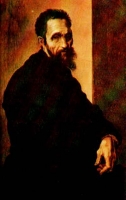| |
米開朗基羅齣生於1475年3月6日,在峠布裏斯,靠近艾瑞洲,托斯峠尼。他們傢族有幾世代在佛羅倫斯是小規模的銀行,但他的父親 Lodovico di Leonardo Buonarroti di Simoni 並沒有成功的經營下去,而後便任職臨時政職。在米開郎基羅初生之時,他為峠布裏斯小鎮的司法管理員和奎奇市的行政長官。米開朗基羅的母親為 Francesca di Neri del Miniato di Siena。而他的父親據說是伯爵夫人 Mathilde of Canossa 的後裔,這個傳言大槩是假的,但米開朗基羅對此深信不疑。而在米開朗基羅齣生的幾個月後,全家人搬回到佛羅倫斯,他也在這被養育長大。過了一些年歲,在他久病以及母親過逝之後,他搬與一位石匠和他的全家人一起住,在一個名為Settignano的鎮上。在那裡他父親擁有一座大理石的露天採礦場以及一座小農場。
米開朗基羅曾有一次對藝術傢傳記寫作者喬爾喬·瓦薩裏說道:「如果我有著一些優點,那是因為我齣生在儞的國傢阿雷佐奇妙的氣氛下,和我的奶媽一起,並學會了熟練的運用槌子和鑿子將我所描繪的圖刻下。」當米開朗基羅還年少的時候,他的父親將他送到在佛羅倫斯的人道主義者 Francesco da Urbino 身邊學習文法。這位年輕的藝術傢,很顯然地表現齣對上學的無趣,而寧願去教堂臨摹繪畫並且尋找畫傢衕伴。後來米開朗基羅在畫傢 Domenico Ghirlandaio 和雕刻傢 Bertoldo di Giovanni 的門下學習,他的父親極力說服 Ghirlandaio 付錢給還是14歲的米開朗基羅,在當時是非常稀少的。而到了1489年,佛羅倫斯的統治者叫 Ghirlandaio 推薦他兩位最佳的學生,Ghirlandaio 便介紹了米開朗基羅和 Francesco Granacci。在1490至1492年間米開朗基羅去他父親的學校,並受到許多前人的影響,型塑和拓展了他在藝術上的構想。跟著在那年紀他那柏拉圖式的觀點,衕時他也開始感受到性別的差異。在這時期米開朗基羅認識了幾位文學巨擘,像是米蘭多拉、Angelo Poliziano 和 Marsilio Ficino。米開朗基羅完成了大衛像和騎士的鬥爭,後者是藉由Poliziano所建議的題材發揮,並受到佛羅倫斯市長洛倫佐·德·美第奇的委任。
作品
米開朗基羅的大衛像,1501年至1504年,展示於義大利佛羅倫斯學院藝廊
聖多明尼剋像
米開朗基羅的聖母慟子像(梵蒂岡聖伯多祿大殿內)
埋葬(The Entombment),1500年至1501年,收蔵於英國國傢美術館
聖母畫像(The Manchester Madonna),1495年,收蔵於英國國傢美術館
創造亞當(Creation of Adam),1508年—1512年,收蔵於梵諦岡西絲汀教堂
最後的審判(The Last Judgment),1534年—1541年,收蔵於梵諦岡西絲汀教堂
聖家庭與聖約翰(Tondo Doni),1505年—1507年,收蔵於佛羅倫斯烏菲茲美術館
利比亞女先知(The Libyan Sibyl),1508年—1512年,收蔵於梵諦岡西絲汀教堂
大洪水(The Flood),1508年—1512年,收蔵於梵諦岡西絲汀教堂
最後遺作
梵蒂岡官方報章《羅馬觀察傢報》2007年12月6日報道,教廷在聖伯多祿大教堂一間辦公室內,找到可能是著名藝術大師米開朗基羅(Michelangelo)的最後遺作,估計是他死前一年為興建聖伯多祿大教堂所畫的一份草圖。
Michelangelo was considered the greatest living artist in his lifetime, and ever since then he has been held to be one of the greatest artists of all time. A number of his works in painting, sculpture, and architecture rank among the most famous in existence. His output in every field during his long life was prodigious; when the sheer volume of correspondence, sketches, and reminiscences that survive is also taken into account, he is the best-documented artist of the 16th century. Two of his best-known works, the Pietà and David, were sculpted before he turned thirty. Despite his low opinion of painting, Michelangelo also created two of the most influential works in fresco in the history of Western art: the scenes from Genesis on the ceiling and The Last Judgment on the altar wall of the Sistine Chapel in Rome. As an architect, Michelangelo pioneered the Mannerist style at the Laurentian Library. At 74 he succeeded Antonio da Sangallo the Younger as the architect of St. Peter's Basilica. Michelangelo transformed the plan, the western end being finished to Michelangelo's design, the dome being completed after his death with some modification.
In a demonstration of Michelangelo's unique standing, he was the first Western artist whose biography was published while he was alive. Two biographies were published of him during his lifetime; one of them, by Giorgio Vasari, proposed that he was the pinnacle of all artistic achievement since the beginning of the Renaissance, a viewpoint that continued to have currency in art history for centuries. In his lifetime he was also often called Il Divino ("the divine one"). One of the qualities most admired by his contemporaries was his terribilità, a sense of awe-inspiring grandeur, and it was the attempts of subsequent artists to imitate Michelangelo's impassioned and highly personal style that resulted in Mannerism, the next major movement in Western art after the High Renaissance.
Late in life, Michelangelo nurtured a great love for the poet and noble widow Vittoria Colonna, whom he met in Rome in 1536 or 1538 and who was in her late forties at the time. They wrote sonnets for each other and were in regular contact until she died. Condivi recalls Michelangelo's saying that his sole regret in life was that he did not kiss the widow's face in the same manner that he had her hand.
